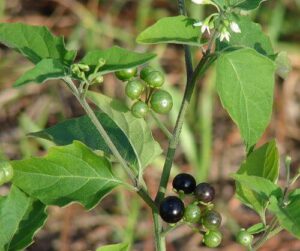Black Nightshade
Overview

Black nightshade is a summer annual or short-lived perennial thorny plant. Its leaves are light green. It is a species of the Solanum genus known as the European Black Nightshade or Blackberry Nightshade. Black nightshade is often confused with the deadly nightshade (Atropa belladonna). Its ripe berries and edible leaves are cooked and eaten in some local areas. People also use completely plants, including leaves, fruits and roots, to make traditional medicine. These berries are often eaten by birds. This plant is cultivated especially in Africa and North America.
Mature the plant
Black nightshade plants are usually 1-2 m tall. A mature plant varies greatly in size and color from erect. The stalks, leaves have some hairs but are not densely hairy or sticky. Although the leaves vary, they are egg-shaped overall with a smooth to the wavy edge and alternate with each other along the stem. Its mature leaves are light green. The trees are sometimes slightly woody at the base. Flowers bloom from March to October. Four to eight star-shaped clusters of white petals grow. The flowers have yellow anthers and stamens in the middle which are light purple and light pink. The fruits are round and soft. When ripe, the berries turn from green to red and then black. Mature berries are black or purple-black and up to one inch (5-8 mm) in diameter. The seeds are egg-shaped, flattened up to 5-8 mm in diameter.
Use
Black nightshade fruits can also be eaten effortlessly. The leaves and roots are used in various medicinal fields. The chemical extract is used to treat diarrhea, stomach complications, and fever. The juice of this plant is used in ulcers and dermatitis. The fruit is used as a tonic, to prevent constipation, aid appetite, and treat asthma, severe thirst, and so on. Boiled leaves and fruit extract is used to relieve liver disease, jaundice. Its root juice is used to treat asthma and whooping cough.
Side effects
Black nightshade is the most problematic plant among other nightshade species. Parts of this plant can be toxic to humans and cattle when eaten. However, the level of toxicity depends on many factors, including plant maturity and environmental conditions. All parts of the plant, except ripe fruit, contain a toxic chemical called toxic glycoalkaloid solanine. And eating immature fruit can cause toxic symptoms like solanine. When eaten in small doses, it can cause nausea, vomiting, headaches and other side effects. At high doses, it can cause severe poisoning. Symptoms of poisoning include irregular heartbeat, shortness of breath, dizziness, drowsiness, twisting of arms and legs, diarrhea, paralysis and even death. It is not safe to take Black Nightshade during pregnancy and breastfeeding. This can cause birth defects in the baby.
Black Nightshade vs. Deadly Nightshade
The black nightshade plant does not mean Atropa belladonna. Unfortunately, the black nightshade plant has considerable confusion with the popular name “Deadly Nightshade”. The green potato and Atropa belladonna plant is deadly nightshade, which is extremely unpleasant and poisonous. Although many continue to describe black nightshade as toxic. People get scared when they hear “Nightshade” But potatoes and tomatoes and peppers and eggplants belong to the nightshade family. Tomatoes from the nightshade family were considered poisonous by many Europeans. But tomatoes are now widely cultivated and eaten around the world.
So, isn’t it deadly?
Black nightshade can produce some toxic alkaloids but the alkaloids are removed when cooked. In fact, a chemical study found that only immature or raw fruits have the potential toxic alkaloids, while ripe berries do not have these toxic alkaloids. The fruits are eaten as food and used by birds all over the world. The ripe black fruits are delicious in taste and make excellent jam. Its leaves are also eaten in vegetables cooked in other countries of the world.